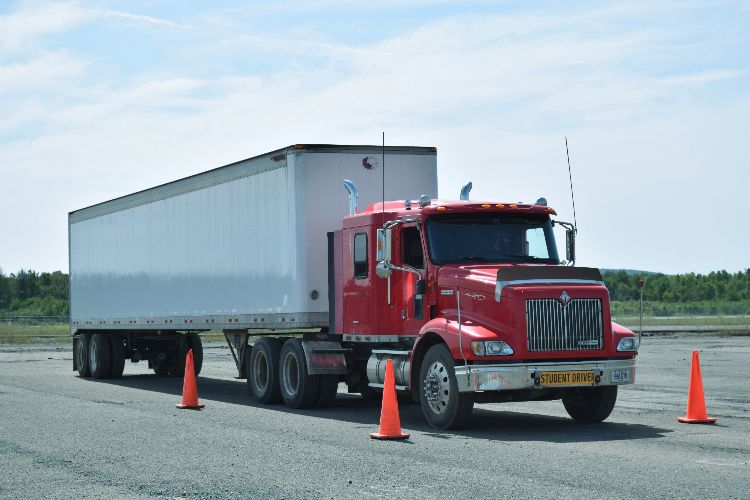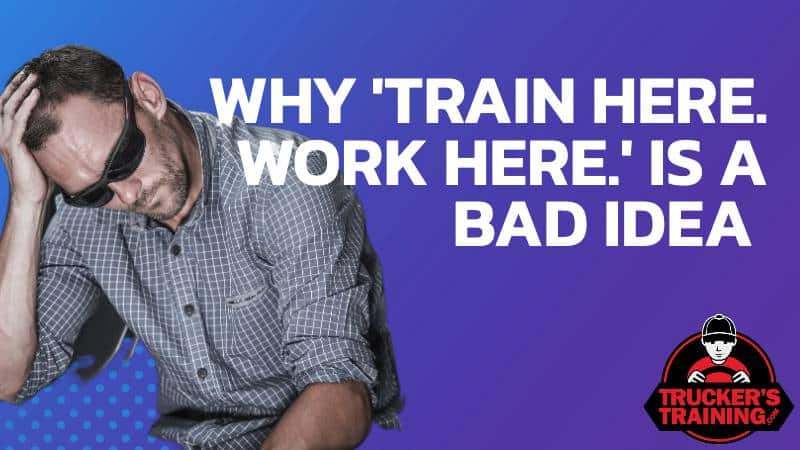
The trucking industry is a vital part of the national transportation system. The safe and efficient moving of cargo is essential for economic prosperity. There is great profit to be made for anyone that can become an efficient part of that system. A truck driver is a vital part of that system. Having a CDL is required to operate a truck, and there are many different ways that a potential driver can obtain a CDL, and “Train here. Work here.” or paid CDL training is one of them. This article will explore why this type of free truck driver training is not a good idea.
Three Types of CDL Schools
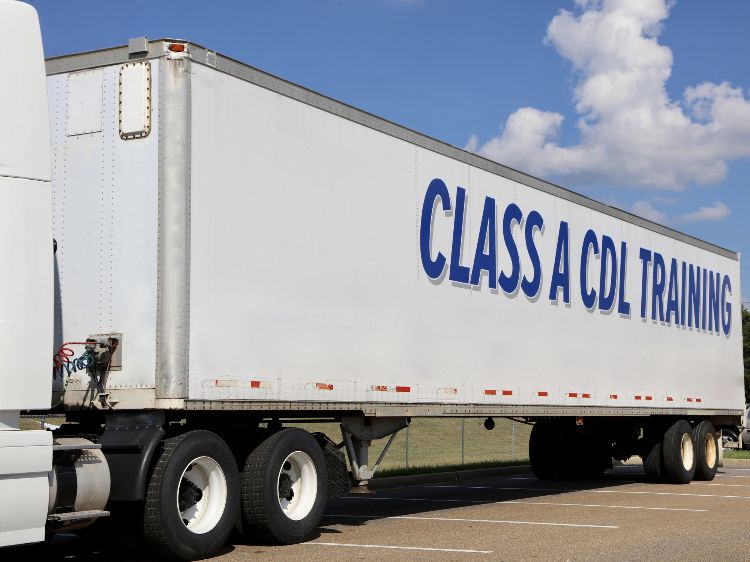
There are three types of truck driving schools:
- A traditional CDL school – where you pay tuition up front, or they arrange for you to pay for school with a loan.
- A “Train here. Work here.” school attached to a large trucking company—where the tuition will be forgiven if you complete an employment contract. (These “Train here. Work here.” schools are sometimes called: “Paid CDL Truck Driver Training”, or “In-house CDL training”, “Paid CDL Training”, or something similar.)
- Alternative schooling (community college, county program).
Entry-Level Driver Training Requirements (“ELDT”)
In 2012, Congress mandated a national, standardized training for persons wishing to obtain a CDL. Effective February 7, 2022, this mandate goes into effect.
You will need to complete the ELDT if:
- You are applying for a class A or B CDL for the first time
- You are upgrading your CDL from Class B to Class A
- You are adding certain endorsements for your license:
- HazMat (H)
- Passenger (P)
- School Buss (S)
Current holders of CDLs are not affected (unless a driver changes class/endorsement(s) as noted above).
All CDL schools will have modified their training program(s) to comply with the ELDT requirements.
Why the “Train Here. Work Here.” Program is a Bad Idea

A seemingly attractive way to get a CDL is to go through a “Train here. Work here.” program, at a school run by a large trucking company. However, there are several potential problems with joining this sort of program:
- Restrictive contracts
- Students are required to pay for incomplete training and/or incomplete contacts
- Only two testing opportunities
- Non-repeating job placement
- Potential for lower training standards/trainer standards
- Lack of breadth of experience
- Lack of job choice
- Lower earnings
- Lack of support
1. Restrictive Contracts

As part of being admitted to a “Train here. Work here.” program, you will be required to sign a contract promising to work for the company that provides the training for a set period of time. Usually, you will be required to work for the company for two years to satisfy the contract.
Sometimes the wording of the contract requires a certain number of miles driven within a certain number of months, or total loads completed, or some other benchmark(s). But, you will be required to complete the contract before the costs of training will be forgiven.
2. Repayment for Incomplete Training

If you do not finish your contract, you will be expected to repay the company for your CDL training. The cost for CDL training can be $5,000 or more. In this example, if you quit your job before the specified time commitment in the contract, you will be required to pay $5,000 to cover the cost of your training.
If you do not pass the driving test in two tries: you flunk out of the program and will be required to repay the company for your CDL training.
3. Testing Limitation
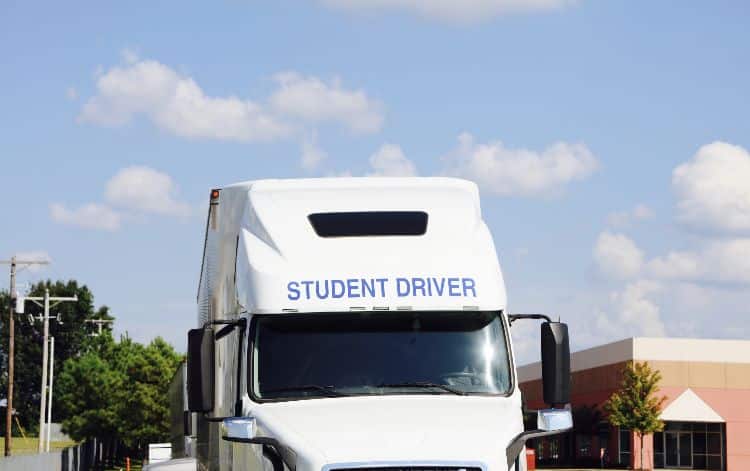
If you pay for training at a traditional CDL school, you will be allowed to use the school’s tractor/trailer for two tries to pass the driving test. (This is the typical number of tries. Every school has different rules and requirements.) If you require a third try to pass the driving test, the school will rent you a tractor/trailer at a discounted rate (usually $50~$100).
A typical “Train here. Work here.” or paid truck driver training will allow only two attempts to pass the driving test. If you fail on the second try—you will be:
- Removed from the program,
- You don’t get your CDL,
- You don’t get the job, and
- You will still owe the school the training costs—typically $5,000.
4. Non-repeating Job Placement
With a traditional driving school, you will receive job placement assistance. Schools maintain a good relationship with companies that have “starter jobs”—jobs for drivers with less than six-months of driving experience. Most schools keep stacks of job applications on hand, ready for each graduating class of students. If, after several months or years, you decide that you want to change companies—a traditional driving school will help you find a new job.
At a “Train here. Work here.” school, you will not receive this sort of help. If you leave the company, you will need to do your own leg work. This is a minor inconvenience—because after you have six-months of solo-driving experience, you can easily find a new driving job—however, this lack of assistance is something to think about.
Full disclosure: If a referred driver completes a certain amount of work, a driving school will receive a finder’s fee. Typically, after the driver is with a company for six months, the referring school gets $500. This does not come out of the driver’s pocket. This sort of referral bonus is normal in the trucking industry.
5. Potential for Lower Training and Trainer Standards
There is no direct evidence that “Train here. Work here.” schools provide sub-standard training. However, with “Train here. Work here.” the emphasis is on graduating students and getting them into the seat of a company truck. Traditional driving schools focus on training students for a variety of different employment situations.
“Train here. Work here.” schools will be much more likely than a traditional school to use senior drivers with zero education experience as temporary CDL instructors.
Unfortunately, with a lack of uniform driver instructor standards, there is only antidotal evidence to suggest that there are lower standards for training—mostly stories passed from one driver to another.
6. Limited Breadth of Experience

A traditional driver school will provide training for a wide variety of trucking situations. Even situations that a new driver will be unlikely to encounter. This will include lessons on how to “throw chains” (put snow chains on tires), handle liquids in a tanker, how to use a converter dolly to attach doubles/triples to the back of a tractor, etc.
If a “Train here. Work here.” company does not use these sorts of equipment, it is unlikely that the training will include much information about these systems.
7. Job Choice Limitation
Upon graduating from a “Train here. Work here.” school, you will be assigned a job. You will not have any real choice in the matter until your contract is finished.
A traditional driving school will assist you in finding a job that best suits your personality. And once employed, you will have a much easier time changing from one driving situation to another.
For example: If you go to a traditional driving school then go to a starter company as a “48/Canada” driver—then decide that you would rather drive “Western 12” (so you can be home more often)—you would have an easier time making that sort of change if you are not under a two year contract.
8. Lower Earnings

If you are under a two-year contract, your rate of pay is determined by the contract. If you are a “at will” employee, you can ask for more money and/or move to a new (better paying) company—especially after you have 6-months of driving experience.
9. Lack of Support
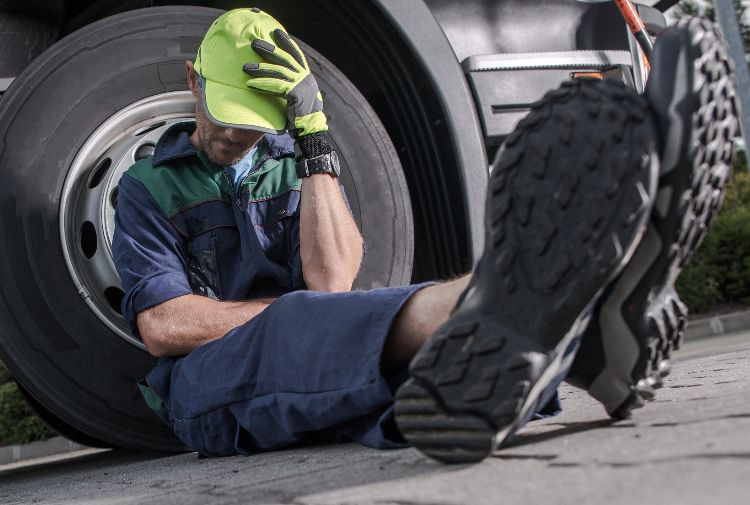
The “Train here. Work here.” company is focused on getting a large number of people through their program so that they can keep there trucks moving.
A traditional school is more interested in the individual student succeeding.
Typical Career Path for Professional Drivers

Regardless how you get your CDL (traditional school, “Train here. Work here.”, or alternative school)—professional drivers’ career tend to follow a common pattern:
- Driving school—five weeks (sometimes six)
- Driving test—one or two days (including waiting time)
- Two weeks getting hired
- Driving on the road with a company trainer (two months)
- Solo driving (six months)
- Look for a better job.
Better companies will not hire a driver until they have six months of solo experience. Six months of experience can be completed within a year of starting driving school.
Note: “Better companies” = better pay
Walking Away
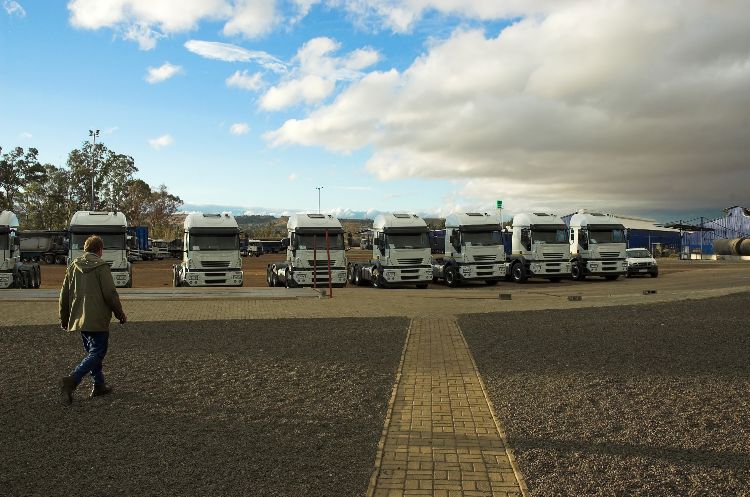
If a job is not working for you, you should be willing to walk away. Even if it means repaying for your schooling. Keep aware of what other companies are paying. Is any extra pay at a new company worth the costs (and hassle) of changing jobs?
Drivers’ Contribution to the Economy
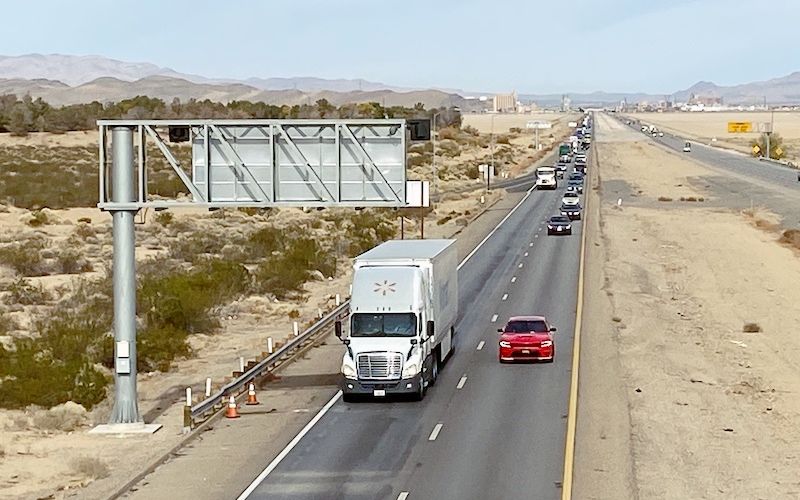
The importance of having a large number of qualified CDL drivers on the road can not be overemphasized. CDL drivers are the backbone of the national logistic system. Virtually everything found in grocery stores and retail shops were transported at one point by a truck.
Trucking companies are always scrambling for drivers. A driver with six-months of experience and a clean driving history should always be able to find work.
However, some training methods are better others.
Alternative Schools

Some community colleges offer CDL training, usually at a reduced cost. The schedules for these classes might be awkward, but it is definitely worth looking into.
Some counties often have vocational training, usually for free or at a discounted rate to qualified residents.
In all cases, be certain that any education you receive is in compliance with Entry-Level Driver Training requirements (“ELDT”).
Conclusion
The “Train here. Work here.” system sounds fast and easy, but depending on how the process works for you—you might have a better experience (including higher pay and better safety) if you go to a traditional CDL school.
For these reasons, I picked a traditional school. They arranged a loan to pay for the program, which I paid off as quickly as I could. The school stepped me through all the steps necessary to get my CDL.
Remember: Trucking companies would not offer “Train here. Work here.” if the program didn’t make them a lot of money.
Disclaimer: The above is based on the writer’s understanding of standard terms and conditions in “Train here. Work here.” programs. Every program is different. Every school is different. You are urged to carefully read (and fully understand) any contract before signing anything.

Michael has had his Class A CDL since 2002, and has worked for several OTR trucking companies. He also drove a truck for the Yellowstone National Park Laundry Department. Michael has worked for two FRA regulated railroads. Then he spent a year driving an ultrasonic, rail-scanning truck on railroad tracks. In addition, Michael has 10 years of experience in logistics and operations where he worked safely with trucks and railroad equipment. Earlier in his life, he was an educator; teaching throughout the U.S. and South Korea.

